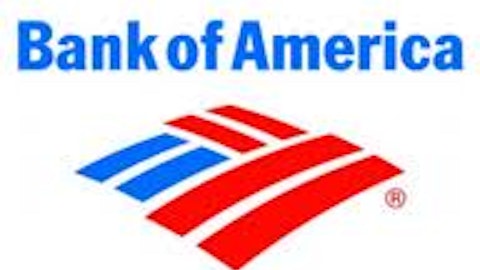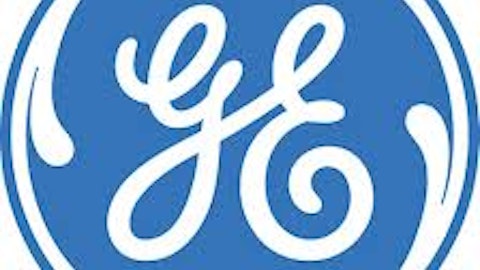Financial services companies are notorious for their complexity and opacity, which confound prediction. Confusingly, Warren Buffett has recently praised banks for their clarity and safety as investments. Could the Oracle of Omaha be wrong, or is Mr. Buffett right as usual?
Below, I will show why active investors should underweight or abstain from financials as an industry. This includes financial stocks like Wells Fargo & Company (NYSE: WFC), U.S. Bancorp (NYSE: USB), Bank of America Corp (NYSE: BAC), and Goldman Sachs Group, Inc. (NYSE: GS) that are long positions for Warren Buffett’s Berkshire Hathaway Inc. (NYSE:BRK.A). Speculators can try to place a cheap bet by looking at valuation, but these bets should be small, regardless of assurances made by the Oracle of Omaha.

According to Wells Fargo Chief Financial Officer Tim Sloan, “Mortgage lending will likely continue to decline as an increase in mortgages for home purchases fails to offset a slowdown in refinancings.” Wells Fargo is the currently the largest mortgage lender in the U.S., and investors have been wondering if the bank can sustain its high profits sparked by a mortgage refinancing boom due to low interest rates. Sloan also said that Wells Fargo still has a “good opportunity” to refinance eligible homeowners. Wells Fargo generated $125 billion in loans during the fourth quarter, a 10% decline from the third quarter. Wells Fargo currently has a P/E ratio of 10.44 and pays a 2.8% dividend yield.
Meanwhile, U.S. Bancorp has invested $930 million in renewable energy projects since 2008. The company invested nearly $250 million in 2012 alone. U.S. Bancorp is the fifth largest commercial bank in the U.S., and the company is expected to earmark over $1 billion in renewable projects over the next five years. U.S. Bancorp announced it will team up with SunPower Corporation (NASDAQ:SPWR) to invest $100 million to install solar-power systems in over 3,000 homes in the U.S. U.S. Bancorp has a P/E ratio of 11.98 and dividend yield of 2.3%.
Bank of America Corp (NYSE:BAC) and Wells Fargo are drawing criticism over their handling of insurance payouts to homeowners impacted by the devastation caused by Hurricane Sandy. According to The Wall Street Journal, they are being pressured by New York Governor Andrew Cuomo to speed up the release of insurance money. Insurance payments are often held by banks and released in stages in cases where properties are mortgaged. According to the article, “Mortgage companies say they operate that way to safeguard the lender’s collateral and protect homeowners from unscrupulous contractors.” Bank of America currently has a P/E ratio of 49.27 and dividend yield of .30%.
Harvey Schwartz, Chief Financial Officer of Goldman Sachs Group, predicted that the banking industry’s average return on equity (ROE) will exceed 12% as some firms shrink or exit businesses. Schwartz said, “I think the industry will migrate to higher returns because it will have to.” Goldman Sachs, the fifth largest U.S. bank in terms of total assets, saw a 3.7% increase in return on average common shareholders’ equity between 2011 and 2012. The bank generated a 10.7% percent return on average common shareholders’ equity in 2012. Schwartz said the 2012 figure was “not particularly aspirational,” and that Goldman Sachs does not have enough information to provide an accurate ROE target. Goldman Sachs has a P/E ratio of 10.95 and dividend yield of 1.30%.
Too Big to Understand
With all due respect to Mr. Buffett, the fundamental problem with financial service firms is that they are too hard to value and too hard to understand. I love buying cheap companies, but when firms are highly leveraged, are allowed to value assets using non-market methods, and offer many products as “financial supermarkets,” they are not worthy candidates for stock picking.
To make this clear, let’s think about the qualities of stocks that would make them good candidates for fundamental analysis. First of all, since most investors use financial statements as a basis for understanding a company, the firm must have reliable financial reporting. This is inconsistent with mark-to-model accounting, which allows for tweaking valuation models to enhance asset values and net income.
Next, a firm must not be too complicated. If it’s too complicated an investor’s valuations for the stock are more likely to be wrong. More complexity means there are more opportunities for risk to creep in. More complexity also makes the company harder to manage. Worse yet, the wilder the product, the harder it is to understand if anyone is actually buying it or if consumers can sustainably buy this product in the future.
Buffet Bank Clarity, Safety
Berkshire Hathaway Inc. Chief Executive Officer Warren Buffett recently assured the public that there was minimal risk that banks would fail. Berkshire has invested heavily in more than four of the biggest U.S. banks and Buffett indicates that the lenders have rebuilt capital and they do not put the stability of the economy at risk. Berkshire has holdings in Wells Fargo, U.S. Bancorp, and Bank of America in addition to $5 billion warrants to buy stock of Goldman Sachs. Buffett is confident that banks are faring well considering the fact that Berkshire’s holdings increased in value after restoration measures were implemented after the crisis. Measures that have been put in place to guarantee the stability of banks, including job cuts and trading assets. According to Buffett, “Our banking system is in the best shape in recent memory.”
Buffett supports the idea of large banks, saying that it is important that banks match up to the size of capital markets. The biggest firms in Canada, for instance, performed better during the crisis, yet they hold a larger market share compared to their counterparts in the U.S. Investors are worried, as can be seen by how shares of many large financial services stocks, including Citigroup and Goldman Sachs, are trading at prices that are below book value.
Buffett indicated that Berkshire would redeem its preferred stock if the banks exercised their call options. The company also has warrants to buy common shares that may generate about $3.2 billion in profits if exercised, but Buffett indicates that the company is in no hurry to make the quick gains. According to Buffett, “Nine years from now I would think that Bank of America as well as Wells Fargo & Company (NYSE:WFC) and probably the other major banks will be worth considerably more money than they are now.”
Risks Remain
On the contrary, many regulators, financial analysts, and former bank executives opine that banks are still a threat to the economy. Many banks have yet to split their investment banking operations from the deposit-taking and lending segments, and this implies that depositors may be directly affected by the risks in investment banking. Shareholders are at a loss since short-term results appear to be better than long term profits, and it poses the question of whether or not managers’ decisions are in their best interest. Excessive risk taking and investing in short-term goals may result to great profits now but a crisis in the future once those decision makers have left the institution. CLSA’s analyst Michael Mayo spoke about the many incentives that spurred risk taking prior to the financial crisis that have not been addressed. According to Mayo, “Twenty years of incentives that were out of whack have not been fixed.”
Troubled Asset Relief Program’s former inspector general Neil Barofsky also holds an opinion that contrasts with Buffett’s guarantee regarding banks. Barofsky expressed concern over the trading losses made by JPMorgan Chase & Co. (NYSE:JPM) and the obscurity that is associated with large institutions, although banks still merged to form larger institutions during and after the financial crisis under the pretext that they would be too big to fail. According to Barofsky, “It’s really almost impossible to tell where those risks are.”
Conclusion
Mr. Barofsky is right to question these firms, and investors seeking excess returns should look elsewhere to other stocks whose financial statements are more meaningful.
The article Buffett Bullish On Banks – Should You Be Too? originally appeared on Fool.com and is written by Bill Edson.
Copyright © 1995 – 2013 The Motley Fool, LLC. All rights reserved. The Motley Fool has a disclosure policy.



